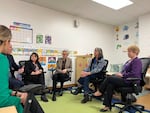
FILE - Gov.-elect Tina Kotek, center, participates in a conversation about early childhood education in Yamhill County in December 2022. A new proposal being considered by the state Legislature would invest $20 million in early childhood educator workforce development.
Julia Shumway / Oregon Capital Chronicle
Over the past few years, the Oregon Legislature has responded to industry-wide labor shortages in manufacturing, tech and health care by directing millions of dollars to workforce development programs. Now, education advocates say it should do the same for child care and preschool teachers.
State Rep. Courtney Neron, D-Wilsonville, introduced House Bill 3011 to direct $20 million over the next two years to growing the number and size of early childhood education degree programs at Oregon’s seven public universities and 17 community colleges. Early childhood education entails child care and preschool programs for kids under the age of 5.
About two-thirds of the funding from House Bill 3011 would go to investments in degree and certificate programs at the state’s public universities and colleges, and the rest would go to on-the-job training programs for enrolled students.
Related: Audit of Oregon early learning department highlights need for equity training and oversight
A 2023 analysis from Oregon State University found that, statewide, there were enough early child care educators for just one in five kids under 2 and about one in three kids between ages 3 and 5. In 12 of Oregon’s 36 counties, less than 10% of kids 2 and younger had access to early childhood education or child care.
“We have centers across our state operating below capacity because of the lack of available qualified early educators. Oregon has centers that maintain an average 18-month long wait list, especially for infant toddler care,” Amy Luhn, director of Oregon State University’s Family Resource Center, told the House Committee on Higher Education and Workforce Development on Tuesday.
Suey Linzmeier, executive director of Head Start of Yamhill County, told the committee that her program had 138 preschool-age kids on its waiting list during the 2023-24 school because it didn’t have enough teachers.
Related: Oregon ranks middle among states for child well-being in new report
The Head Start program requires teachers to have at least an associate degree in early childhood education or a related field. Statewide, about half of child care providers have an associate, bachelor’s or graduate degree, and about one-quarter have some college, a certificate or a foreign degree, according to Oregon State’s analysis.
More qualified teachers could have helped Yamhill Head Start not only serve more kids, but keep more of its funding during the 2023-24 school year.
“We had to reduce the number of children we serve and give back $1 million of funding that would have supported families in Yamhill County,” she told the committee.
Oregon Capital Chronicle is part of States Newsroom, a network of news bureaus supported by grants and a coalition of donors as a 501(c)(3) public charity. Oregon Capital Chronicle maintains editorial independence. Contact Editor Lynne Terry for questions: info@oregoncapitalchronicle.com. Follow Oregon Capital Chronicle on Facebook and X.
This republished story is part of OPB’s broader effort to ensure that everyone in our region has access to quality journalism that informs, entertains and enriches their lives. To learn more, visit opb.org/partnerships.